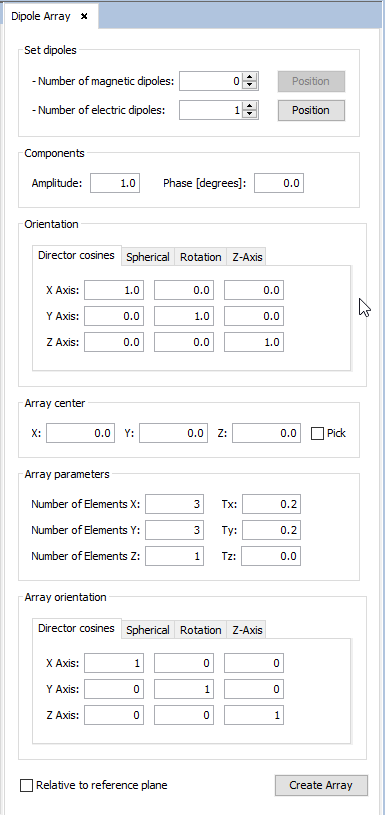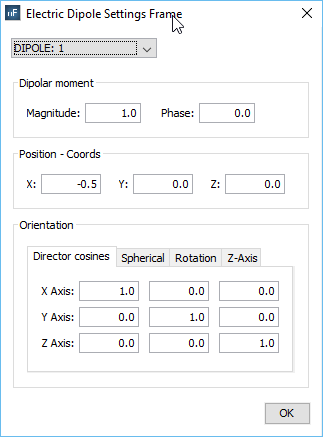Dipole Array
The "Dipole Array" operation is a faster way for generating multiple dipole antennas when they are located in an array structure, where a set of closely located dipoles should be simulated. To create a Dipole Array, select a Dipole Array source to display the Dipole Array panel, as shown in the figure:

The following settings are available for defining the parameters of the overall dipole structure.
- Set dipoles this setting specifies how many magnetic and electric dipoles have to be
generated. This feature is covered later in this section.
- Number of magnetic dipoles: set the number of magnetic dipoles that each one of the generated dipole will have.
- Number of electric dipoles: set the number of electric dipoles that each one of the generated dipole will have.
- Components: the amplitude and phase for the dipole moment for each generated antenna.
- Array orientation: dipole antenna rotation. There are multiple
ways for setting the orientation.
- Director cosines: manually set the director cosines for the dipole.
- Spherical set the orientation using spherical system (theta, phi, alpha).
- Rotation: specify X, Y and Z angles as degrees.
- Z-Axis: this option can be used for manually defining the local Z-axis of the dipole.
- Array center: the Cartesian center for the generated dipole array structure. For a more precise mode, pickpoint mode can be enabled. Select Pick, then click anywhere in the 3D Panel. The position fields will be filled with the coordinates of the clicked point.
- Array parameters: this setting lets the user specify the number of dipoles to be generated and the separation between each dipole.
- Array orientation: similar to the dipole orientation, this control lets the user specify the array rotation.
When the number of magnetic dipoles is greater than 0, the position and orientation of magnetic dipoles can be selected by pressing the Position button.
When the number of magnetic dipoles is greater than 0, the position and orientation of magnetic dipoles can be selected by pressing the Position button.

The selector at the top of the window lists every possible magnetic dipole defined in the antenna. The following settings can be defined:
- Dipolar moment: values for the magnetic dipole moment, magnitude and phase, can be set here.
- Position: Cartesian coordinates for the magnetic dipole, relative to the location of the antenna.
- Orientation: similar to the rotation controls under Dipole tab, this setting lets the user set the rotation for this magnetic dipole using either Director cosines, Spherical, Rotation or Z-Axis values.
Similarly, when the number of electric dipoles is higher than 0, the position and rotation for every electric dipole can be set by pressing the Position button.

The behaviour of this dialog is similar to the one for setting magnetic dipoles.
When all the parameters have been set, press Create Array to create the dipoles. Note that the dipole generation will create separate dipoles. This means that after generating the dipole array, you will be able to modify the values for each dipole separately.
